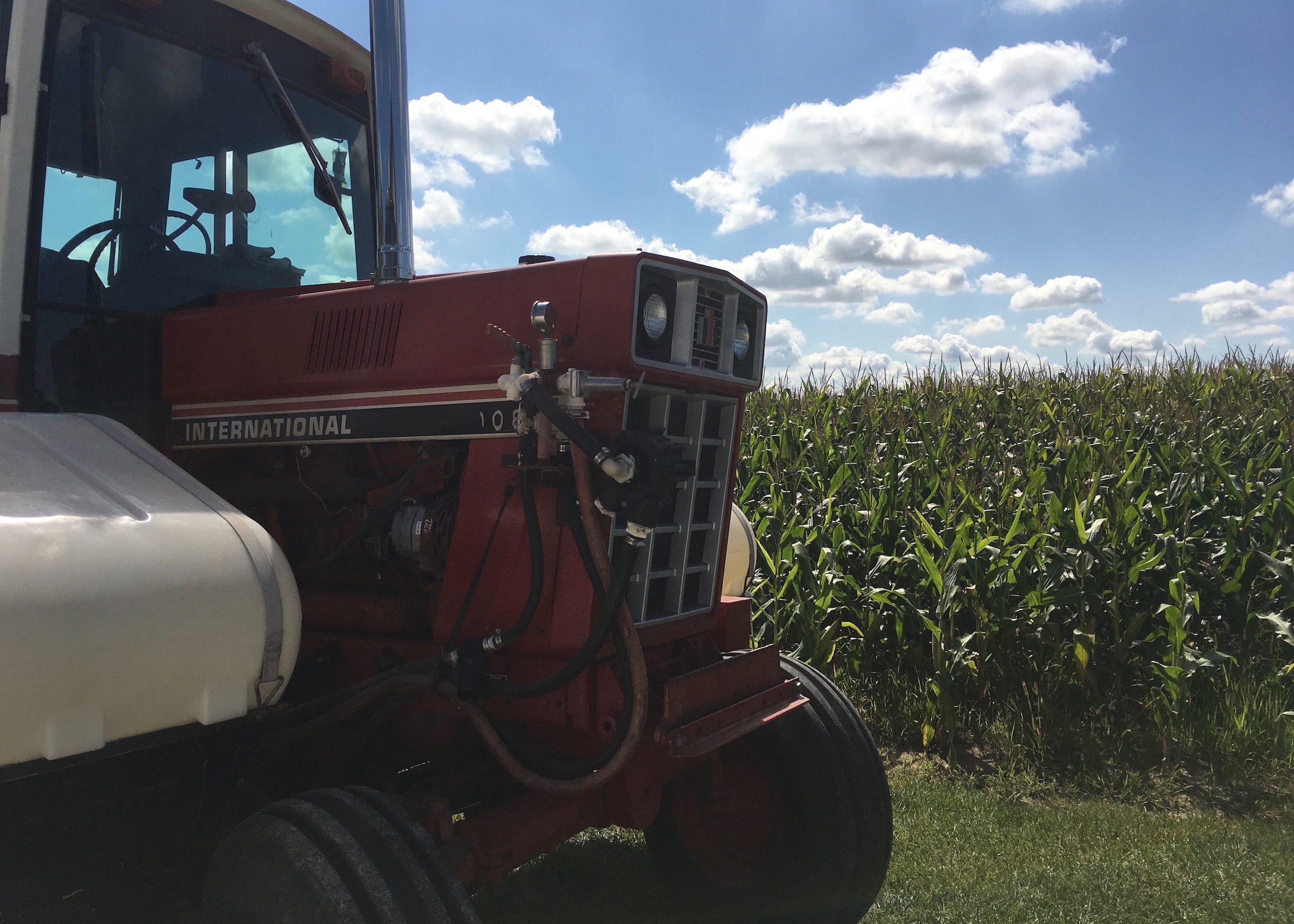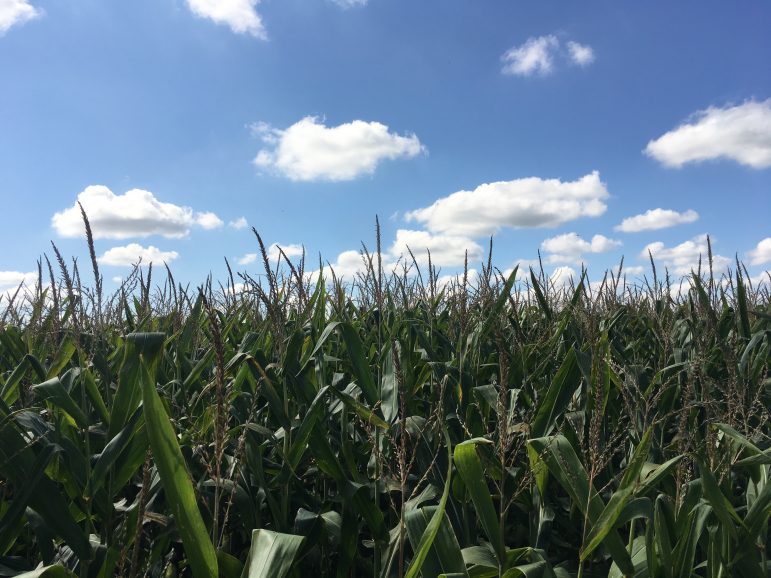
Farms like this one, in Ottawa County, Ohio, not far from Lake Erie, have a big part to play in determining local water quality. Image: Steven Maier.
By Steven Maier
Federal officials are launching a two-year study to determine the best ways to convince farmers to help fight water pollution in the Great Lakes region.
The pollution has created conditions ripe for excessive algal blooms that perennially appear in Lake Erie and other lakes and bays and threaten water quality. The culprit: nutrient-laden runoff, much of which comes from farmland.
It’s an issue that has forced national, regional and local agencies, organizations and universities to collaborate on a solution. Their goal: convince more farmers across the Great Lakes region to implement sustainable farming practices.
That’s not always easy, said Great Lakes Commission Program Director Victoria Pebbles.
“It’s very, very difficult because farmers are proud, they’re private and they feel like the finger’s being pointed at them,” she said. “And most of these people are honest people and hardworking people who are just trying to do their best.”
Interest from farmers is substantial, said Brian Buehler, the Michigan Natural Resources Conservation Service public affairs specialist. But they often need help bearing the financial burden.
“Producers have been doing this for a long time, and they’re tried and true practices, so getting anyone to change is, it’s a challenge,” Buehler said. “They need to see it makes economic sense for them, because you know, it is a business.”
The Great Lakes Commission begins a two-year study in November, looking to stream federal sustainable practices subsidy dollars more efficiently into the hands of county officials and the pockets of farmers. The Great Lakes Restoration Initiative has put more than $100 million into those pockets over the past six years, according to the Great Lakes Commission.
The U.S. House of Representatives voted in September to continue funding the restoration initiative, despite President Donald Trump’s proposal to zero out all of its $300 million funding from the federal budget. Deliberation over the cut continues in the U.S. Senate.
The commission will assess which programs are best at reducing agricultural runoff in four watersheds: Wisconsin’s Lower Fox River, Michigan’s Saginaw River, New York’s Genesee River and the Maumee River, which winds through Indiana, Michigan and Ohio. The practices of many farmers in those watersheds have already been the subject of prior studies, and the commission also has access to data submitted annually by each initiative-funded project.
Battling algal blooms and poor water quality has been a main focus for the initiative since it launched in 2012. It funds more than 90 programs to reduce farm runoff, Pebbles said.
Algae blooms in 2014 tainted tap water in Toledo, Ohio, causing shutoffs for 500,000 residents.
The bulk of the work comes from local governments like the Outagamie County Land Conservation Department, in Appleton, Wisconsin. It’s part of the Lower Fox River watershed and just outside of Green Bay. Like much of the Great Lakes, the bay is plagued by algal blooms–killing fish, forcing beach closings and damaging the local economy.
County officials’ feedback is critical, Pebbles said. They’re the ones who know what’s working.
Runoff reduction won’t happen without large-scale buy-in from the farmers, said Greg Baneck, a county conservationist with 14 years under his belt in Outagamie.
“Basically, we are the local delivery method for getting the conservation on the ground,” Baneck said. “That’s the only way we’re getting down to the water quality standards, is if we have the funding for the boots on the ground.”
The Great Lakes Restoration Initiative has helped immensely on that front, he said. It allows the county to employ 12 full-time conservation staffers, up from seven. That makes it easier to meet directly with farmers.
Initiative funding has also made it cheaper for farmers to implement watershed-friendly practices, Baneck said. The county shares the cost of things like seeds for cover crops that keep the soil packed after harvest when fields would otherwise be brown and bare. It has also bought expensive conservation-friendly equipment that is loaned to farmers.
Outagamie County loans out their crimper roller, a machine that crushes and kills cover crops, clearing the way for planting and creating a protective bed over the seed. The decomposing stalks then fertilize the seed.

Another conservation practice: planting strips of grass around crops to filter nutrients from runoff. The kicker: it takes up valuable ground for planting. Image: Steven Maier.
Farmers can also cost-share installment of drainage tiles, which help regulate the amounts of runoff.
They’ve seen a mindset change, Baneck said.
“Most farmers want to do the right thing,” he said. “If we can show them the financial benefit of it, that’s huge.
“Bottom line, everyone wants to still make a profit and help the environment, and that’s what we’re showing them.”
As more farmers see their neighbors adopt new practices, the momentum builds, Baneck said.
Experts elsewhere agree.
“I think the farmers realize that they can have a big impact,” said Ben Thelen, a district conservationist with the Saginaw Conservation District, in Saginaw, Michigan. “And you know, a lot of them want to do the right thing.”
Farmers in the Saginaw River watershed used to compete for conservation grants from the U.S. Department of Agriculture, Thelen said. A waiting list formed.

Sustainable farming practices can often be expensive to implement. Image: Steven Maier.
Farmers still compete for funds, but the Saginaw River watershed’s priority designation narrowed the competitive pool and allowed more farmers to make changes, he said.
Similarly, collaboration and federal funding has aided county officials in the Genesee River watershed in New York.
Water quality-related problems have persisted there for years, said Molly Cassatt, district manager of the Genesee County Soil and Water Conservation District.
Her district has partnered with 11 others to form The Genesee River Watershed Coalition of Conservation Districts, she said. The coalition crosses state lines, with one county hailing from Pennsylvania.
“We’re going to work together so that these projects aren’t small and scattered, but really address the worst areas of the watershed,” Cassatt said.
And with programs “saturated with money” from federal sources, she said, adoption of conservation practices has hastened as farmers no longer have to wait long periods until they’re able to sign up for cost-sharing programs.
That increased buy-in from farmers is what the Great Lakes Commission is looking for.
“What we want to know is, what’s changing behavior in the long-term?” Pebbles said. “If the money went away tomorrow, would they continue to implement these conservation practices?”
The study’s core team is composed of officials from the commission, Michigan State University and Ohio State University. The commission will also assemble an advisory team composed of county officials from those watersheds.
